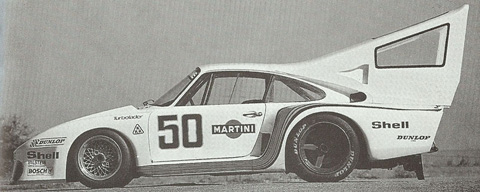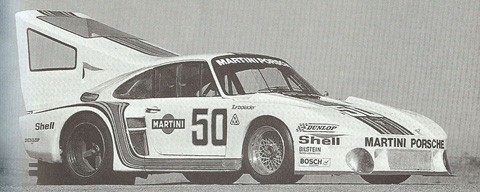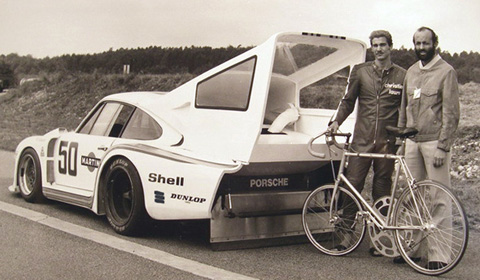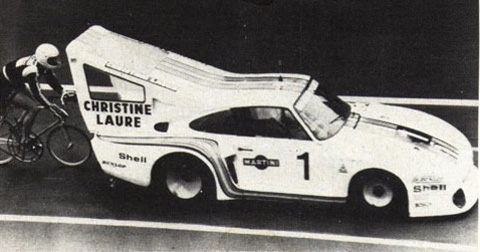Jean Claude Rude was an ambitious man, back in 1979 the French cyclist wanted to break the world bicycle speed record. In order to become the world’s fastest on bike, he had to go faster than his fellow countryman José Meiffret who had set the record at an impressive 204.7km/h (127.2mph) in 1962. This amazing speed was achieved on the German Autobahn, presumably closed for other traffic, near Freiburg where Meiffret was riding in the slipstream of a Mercedes-Benz 300 SL.
This form of cycling is known as motor-paced racing. The cyclist follows as close as he can to profit from the slipstream of his pacer, which could either be a car or motorcycle. The slipstream created by the pacer increases speed and endurance of the cyclist, allowing him to reach speeds normally associated with sports cars. The current world record is 278.8km/h (167mph) set by Dutchman Fred Rompelberg in 1995.

Let’s go back to 1979: Jean Claude Rude had set his sight on a speed of 240km/h, so he needed a powerful sports car capable of reaching those speeds. Rude contacted Porsche, who were willing to help him. The Germans modified a 935, the successful racing car with an enormous amount of power up to 800 horsepower, which dominated endurance racing in those days. The Porsche 935 received an odd-looking rear end designed to reduce drag for the following Jean Claude.

He received more support from the Germans when he was allowed to pedal himself to a new world record at Ehra-Lessien, Volkswagen’s test track near Wolfsburg. Built during the Cold War, the location of this track was chosen because it was in a no-fly zone near the East German border. But more important, Ehra-Lessien has an unbroken straight nine kilometers in length. In fact, the straight is so long, that if you stood on one side of the straight, you wouldn’t be able to see the other end due to the curvature of the Earth. This is also the straight where the top speed of the Bugatti Veyron and the McLaren F1 were recorded, including James May’s run. And this was the straight where Jean Claude would break the world bicycle speed record.

The Porsche 935 was driven by Henri Pescarolo. The bearded Frenchman is nowadays known for his own team which competes in endurance racing, but in those days he was still active as a racing driver. The redesigned rear of the Porsche affected its drivability, the 935 was found to be particularly unstable. To make matters even worse, the Porsche 935 featured a large turbocharger which caused turbo lag followed shortly by a fireball spitting from the exhaust. The latter issue was solved by piping the exhaust to the side of the car, but the turbo lag remained troubling.
Jean Claude Rude needed to stay in the slipstream, not only to ‘get a tow’ from the car in front but also to be protected from the ‘wall of air’. Air resistance is by far the greatest force opposing the forward motion of the cyclist, but it can be dramatically reduced by riding in the slipstream. At high speeds, air resistance has a tremendous effect. The faster you are moving, the more frequently and harder you’ll collide with the molecules in the air. It’s these collisions that create air resistance. More than the length of a bicycle and the benefit of slipstream disappears, this explains why the cyclist needed to get so close. If Pescarolo didn’t accelerate smoothly, which was tricky due to the turbo lag than Jean Claude would collide with a wall of air which would undoubtedly knock him down.

Everything went well until they reached a speed of 160km/h (100mph) when suddenly Jean Claude’s rear tire exploded and was torn from the wheel. Remarkably, he managed to prevent a crash and came to a standstill without any injuries or whatsoever. Disappointed with the failed record attempt, but nevertheless happy to be still alive, Jean Claude ordered Michelin to build new and better tyres for a second attempt. Unfortunately a new record run never happened.
Jean Claude started an investigation on his own to experience the effect of a sudden increase in air resistance, which would occur if he would drop out of the Porsche’s slipstream. He decided that the best way to experience the wall of air was to cycle alongside a railway track and to feel the air displaced by an oncoming train. Instead of being hit by a wall of air, Jean Claude Rude was apparently hit by the train. Ironically a quite rude ending for Rude.
[References: PorschePurist.com and RTL GP Magazine, number 04/2012]

















that’s sooo gay!
Great story, Chris! Good job confirming Rude’s death by train. We couldn’t find anything on it. If you note on Jalopnik, that story is actually ours from http://993c4s.com/porsche-culture/porsche-factoids/land-speed-record-bicycle-rude/
We would love it, and greatly appreciate it, if you update the reference to the actual source!